Page 311 of 519

CAUTION!
Never race the engine with the brakes on and the
vehicle in gear, and never hold the vehicle on an
incline without applying the brakes. These practices
can cause overheating and damage to the
transmission.
Torque Converter Clutch
A feature designed to improve fuel economy has been
added to the automatic transmission of this vehicle. A
clutch within the torque converter engages automatically
at calibrated speeds. This may result in a slightly differ-
ent feeling or response during normal operation in high
gear. When the vehicle speed drops, or during accelera-
tion, the clutch automatically and smoothly disengages.NOTE:
•The torque converter clutch will not engage until the
transmission fluid and engine coolant is warm (usu-
ally after 1–3 miles [1.6–4.8 km] of driving). Because
engine speed is higher when the torque converter
clutch is not engaged, it may seem as if the transmis-
sion is not shifting into “Overdrive” when cold. This is
considered a normal condition. Pulling the selector
lever into the “3” position will show that the transmis-
sion is able to shift into and out of “Overdrive.”
•If the vehicle has not been driven for several days, the
first few seconds of operation after shifting the trans-
mission into gear may seem sluggish. This is due to the
transmission fluid partially draining from the torque
converter into the transmission. This is considered a
normal condition and it will not cause damage to the
transmission. The torque converter will refill within 5
seconds of shifting from “P” (Park) into any other gear
position.
STARTING AND OPERATING 311
5
Page 312 of 519
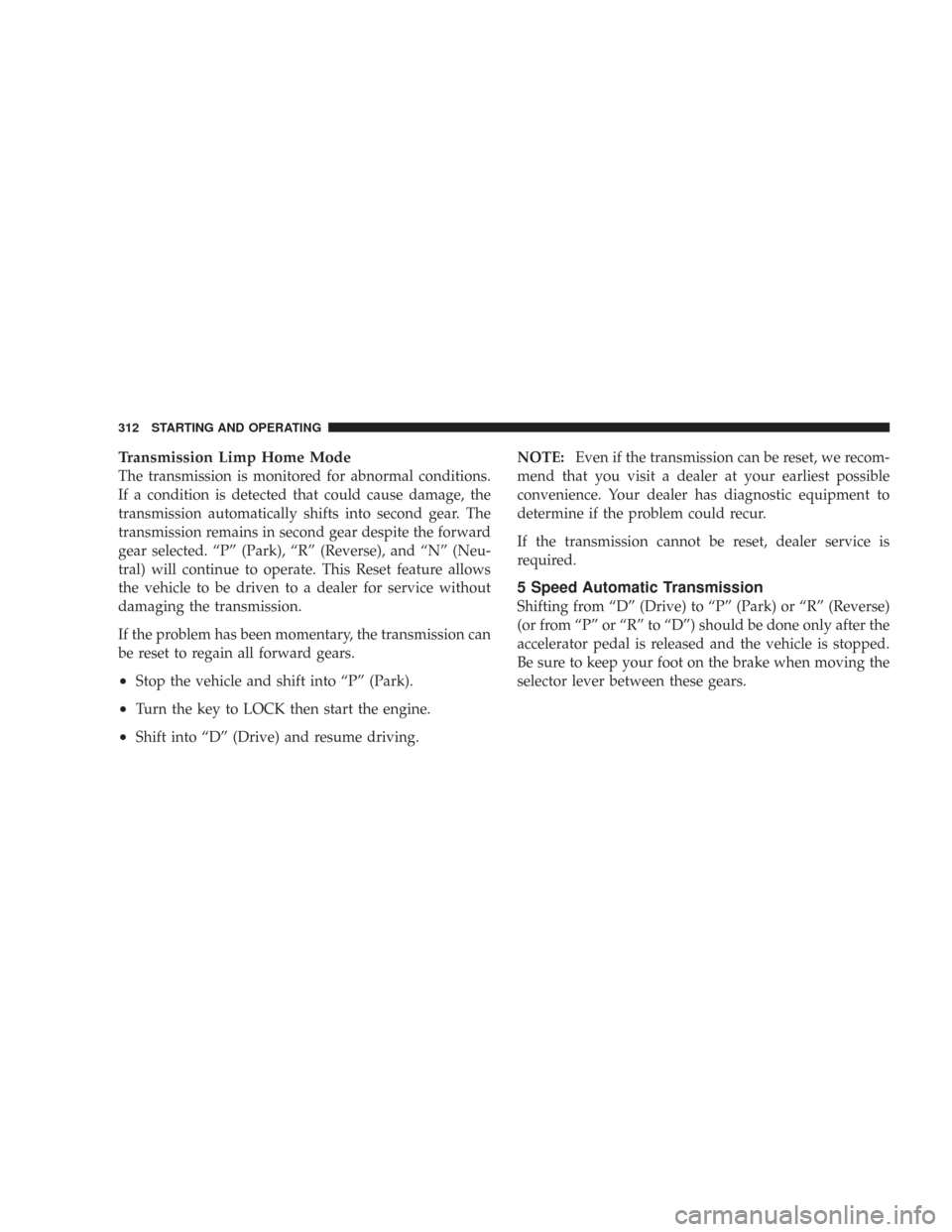
Transmission Limp Home Mode
The transmission is monitored for abnormal conditions.
If a condition is detected that could cause damage, the
transmission automatically shifts into second gear. The
transmission remains in second gear despite the forward
gear selected. “P” (Park), “R” (Reverse), and “N” (Neu-
tral) will continue to operate. This Reset feature allows
the vehicle to be driven to a dealer for service without
damaging the transmission.
If the problem has been momentary, the transmission can
be reset to regain all forward gears.
•Stop the vehicle and shift into “P” (Park).
•Turn the key to LOCK then start the engine.
•Shift into “D” (Drive) and resume driving.NOTE:Even if the transmission can be reset, we recom-
mend that you visit a dealer at your earliest possible
convenience. Your dealer has diagnostic equipment to
determine if the problem could recur.
If the transmission cannot be reset, dealer service is
required.
5 Speed Automatic Transmission
Shifting from “D” (Drive) to “P” (Park) or “R” (Reverse)
(or from “P” or “R” to “D”) should be done only after the
accelerator pedal is released and the vehicle is stopped.
Be sure to keep your foot on the brake when moving the
selector lever between these gears.
312 STARTING AND OPERATING
Page 315 of 519
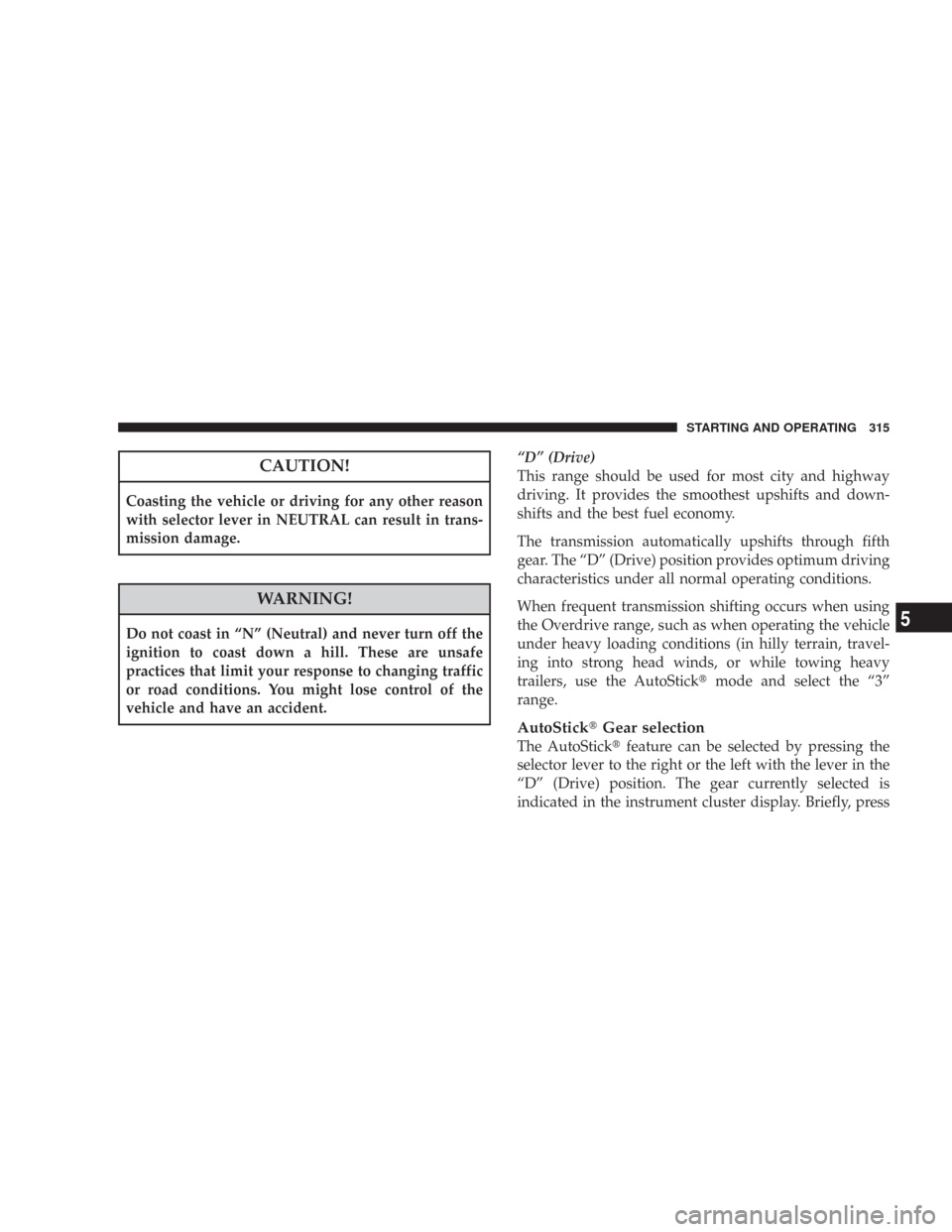
CAUTION!
Coasting the vehicle or driving for any other reason
with selector lever in NEUTRAL can result in trans-
mission damage.
WARNING!
Do not coast in “N” (Neutral) and never turn off the
ignition to coast down a hill. These are unsafe
practices that limit your response to changing traffic
or road conditions. You might lose control of the
vehicle and have an accident.“D” (Drive)
This range should be used for most city and highway
driving. It provides the smoothest upshifts and down-
shifts and the best fuel economy.
The transmission automatically upshifts through fifth
gear. The “D” (Drive) position provides optimum driving
characteristics under all normal operating conditions.
When frequent transmission shifting occurs when using
the Overdrive range, such as when operating the vehicle
under heavy loading conditions (in hilly terrain, travel-
ing into strong head winds, or while towing heavy
trailers, use the AutoStick�mode and select the “3”
range.
AutoStick�Gear selection
The AutoStick�feature can be selected by pressing the
selector lever to the right or the left with the lever in the
“D” (Drive) position. The gear currently selected is
indicated in the instrument cluster display. Briefly, press
STARTING AND OPERATING 315
5
Page 318 of 519
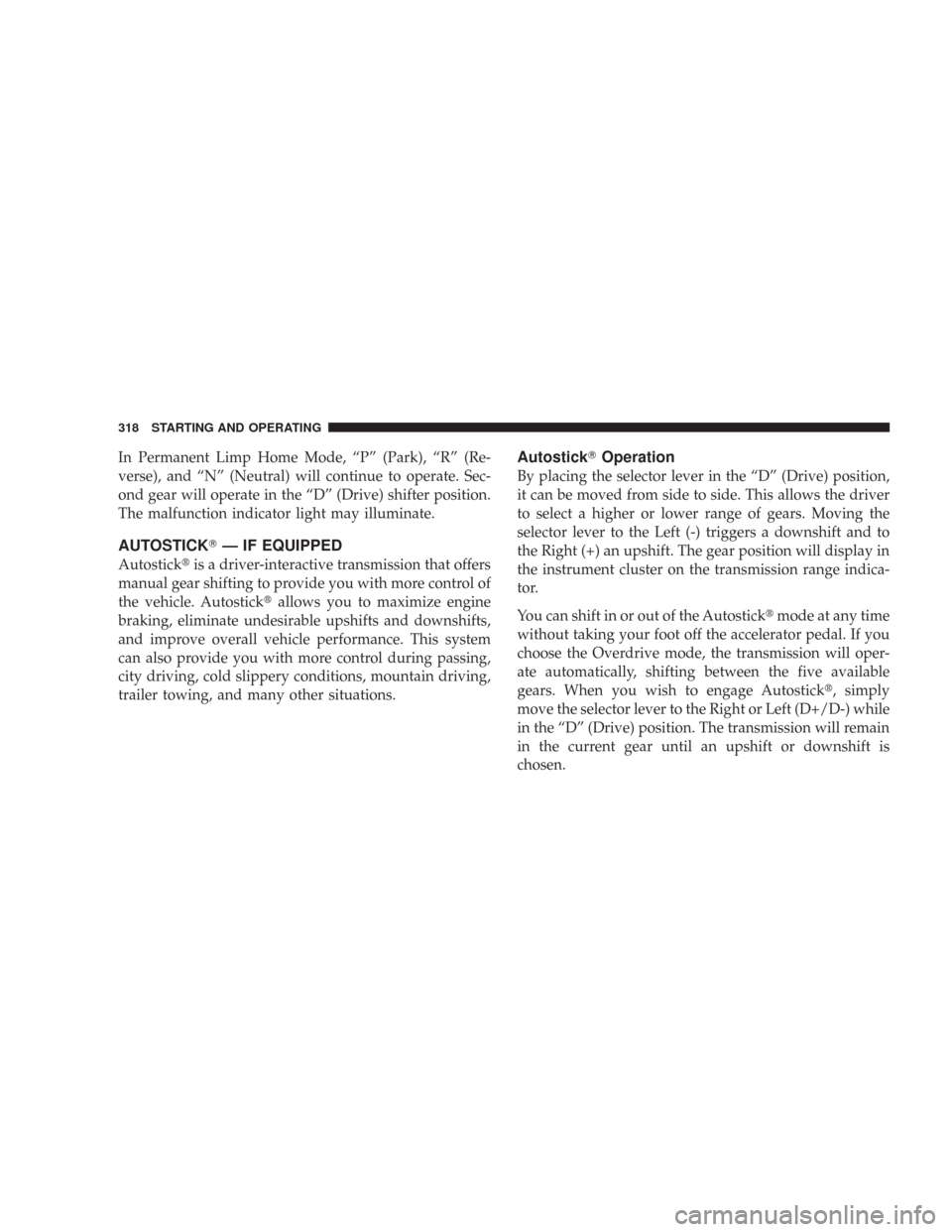
In Permanent Limp Home Mode, “P” (Park), “R” (Re-
verse), and “N” (Neutral) will continue to operate. Sec-
ond gear will operate in the “D” (Drive) shifter position.
The malfunction indicator light may illuminate.
AUTOSTICK�— IF EQUIPPED
Autostick�is a driver-interactive transmission that offers
manual gear shifting to provide you with more control of
the vehicle. Autostick�allows you to maximize engine
braking, eliminate undesirable upshifts and downshifts,
and improve overall vehicle performance. This system
can also provide you with more control during passing,
city driving, cold slippery conditions, mountain driving,
trailer towing, and many other situations.
Autostick�Operation
By placing the selector lever in the “D” (Drive) position,
it can be moved from side to side. This allows the driver
to select a higher or lower range of gears. Moving the
selector lever to the Left (-) triggers a downshift and to
the Right (+) an upshift. The gear position will display in
the instrument cluster on the transmission range indica-
tor.
You can shift in or out of the Autostick�mode at any time
without taking your foot off the accelerator pedal. If you
choose the Overdrive mode, the transmission will oper-
ate automatically, shifting between the five available
gears. When you wish to engage Autostick�, simply
move the selector lever to the Right or Left (D+/D-) while
in the “D” (Drive) position. The transmission will remain
in the current gear until an upshift or downshift is
chosen.
318 STARTING AND OPERATING
Page 380 of 519
Trailer Towing Weights (Maximum Trailer Weight
Ratings)
The following chart provides the maximum trailer
weight ratings towable for your given drivetrain.
Engine/Transmission Frontal Area Max. GTW
(Gross Trailer Wt.)Max. Tongue Wt.
2.7L & 3.5L Rear Wheel
Drive (RWD) Automatic22 SQ. FT.
(2.04 square meters)Up to 2 persons & Luggage
1,000 lbs (454 kg)100 lbs (45 kg)
22 SQ. FT.
(2.04 square meters)Up to 3 persons & Luggage
1,000 lbs (454 kg)100 lbs (45 kg)
22 SQ. FT.
(2.04 square meters)Up to 4 persons & Luggage
1,000 lbs (454 kg)100 lbs (45 kg)
22 SQ. FT.
(2.04 square meters)Up to 5 persons & NO Luggage
1,000 lbs (454 kg)100 lbs (45 kg)
380 STARTING AND OPERATING
Page 381 of 519
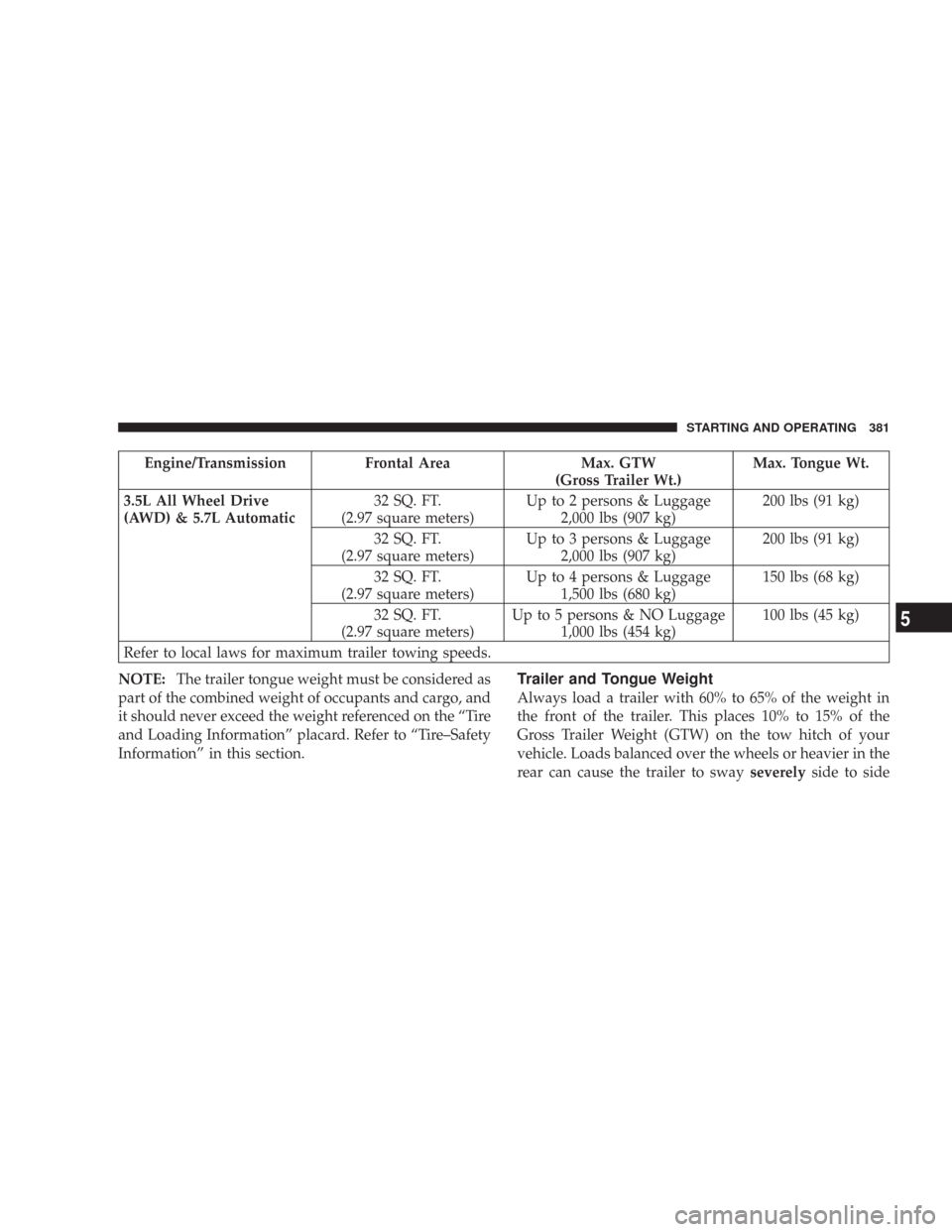
Engine/Transmission Frontal Area Max. GTW
(Gross Trailer Wt.)Max. Tongue Wt.
3.5L All Wheel Drive
(AWD) & 5.7L Automatic32 SQ. FT.
(2.97 square meters)Up to 2 persons & Luggage
2,000 lbs (907 kg)200 lbs (91 kg)
32 SQ. FT.
(2.97 square meters)Up to 3 persons & Luggage
2,000 lbs (907 kg)200 lbs (91 kg)
32 SQ. FT.
(2.97 square meters)Up to 4 persons & Luggage
1,500 lbs (680 kg)150 lbs (68 kg)
32 SQ. FT.
(2.97 square meters)Up to 5 persons & NO Luggage
1,000 lbs (454 kg)100 lbs (45 kg)
Refer to local laws for maximum trailer towing speeds.
NOTE:The trailer tongue weight must be considered as
part of the combined weight of occupants and cargo, and
it should never exceed the weight referenced on the “Tire
and Loading Information” placard. Refer to “Tire–Safety
Information” in this section.
Trailer and Tongue Weight
Always load a trailer with 60% to 65% of the weight in
the front of the trailer. This places 10% to 15% of the
Gross Trailer Weight (GTW) on the tow hitch of your
vehicle. Loads balanced over the wheels or heavier in the
rear can cause the trailer to swayseverelyside to side
STARTING AND OPERATING 381
5
Page 384 of 519
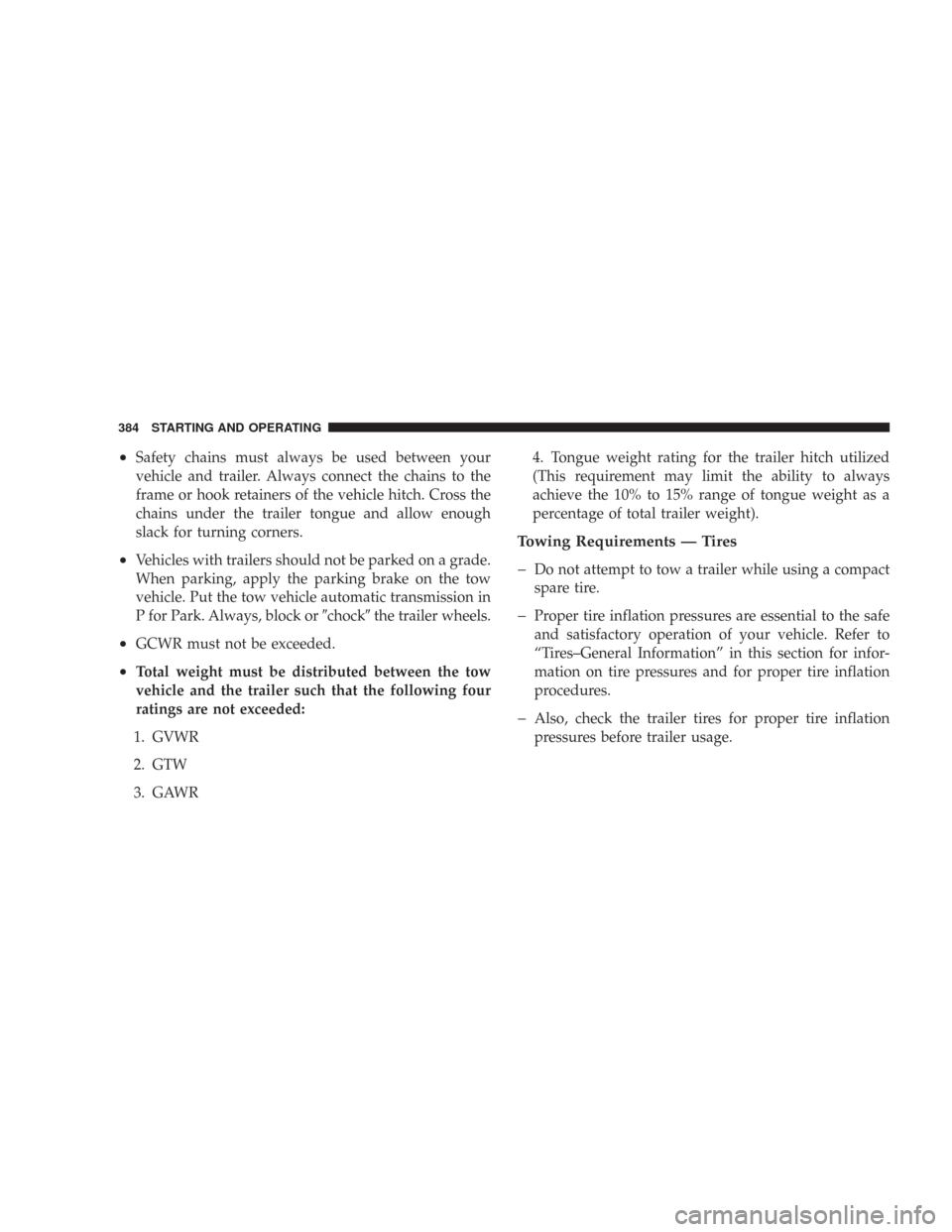
•Safety chains must always be used between your
vehicle and trailer. Always connect the chains to the
frame or hook retainers of the vehicle hitch. Cross the
chains under the trailer tongue and allow enough
slack for turning corners.
•Vehicles with trailers should not be parked on a grade.
When parking, apply the parking brake on the tow
vehicle. Put the tow vehicle automatic transmission in
P for Park. Always, block or�chock�the trailer wheels.
•GCWR must not be exceeded.
•Total weight must be distributed between the tow
vehicle and the trailer such that the following four
ratings are not exceeded:
1. GVWR
2. GTW
3. GAWR4. Tongue weight rating for the trailer hitch utilized
(This requirement may limit the ability to always
achieve the 10% to 15% range of tongue weight as a
percentage of total trailer weight).
Towing Requirements — Tires
�
Do not attempt to tow a trailer while using a compact
spare tire.
�Proper tire inflation pressures are essential to the safe
and satisfactory operation of your vehicle. Refer to
“Tires–General Information” in this section for infor-
mation on tire pressures and for proper tire inflation
procedures.
�Also, check the trailer tires for proper tire inflation
pressures before trailer usage.
384 STARTING AND OPERATING
Page 388 of 519
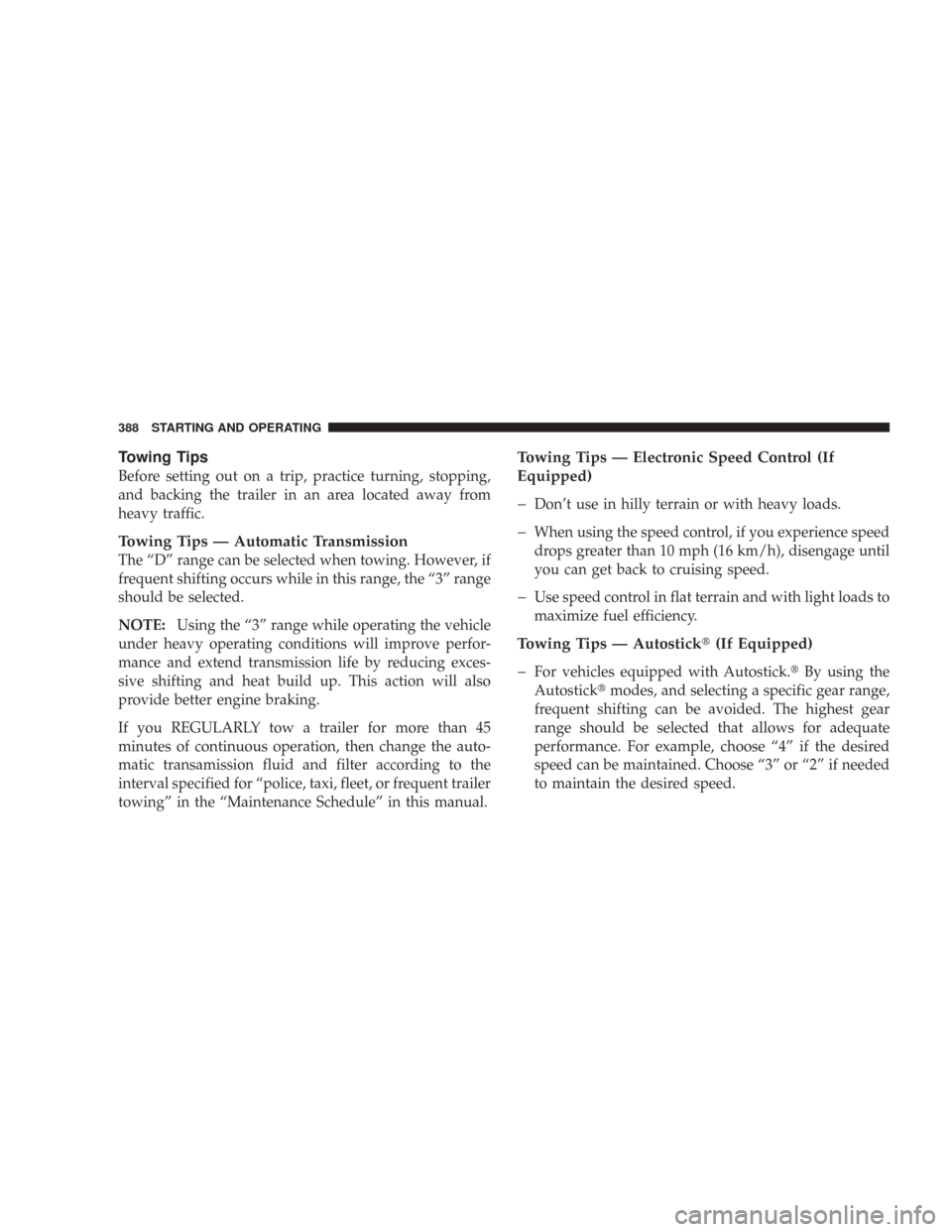
Towing Tips
Before setting out on a trip, practice turning, stopping,
and backing the trailer in an area located away from
heavy traffic.
Towing Tips — Automatic Transmission
The “D” range can be selected when towing. However, if
frequent shifting occurs while in this range, the “3” range
should be selected.
NOTE:Using the “3” range while operating the vehicle
under heavy operating conditions will improve perfor-
mance and extend transmission life by reducing exces-
sive shifting and heat build up. This action will also
provide better engine braking.
If you REGULARLY tow a trailer for more than 45
minutes of continuous operation, then change the auto-
matic transamission fluid and filter according to the
interval specified for “police, taxi, fleet, or frequent trailer
towing” in the “Maintenance Schedule” in this manual.
Towing Tips — Electronic Speed Control (If
Equipped)
�
Don’t use in hilly terrain or with heavy loads.
�When using the speed control, if you experience speed
drops greater than 10 mph (16 km/h), disengage until
you can get back to cruising speed.
�Use speed control in flat terrain and with light loads to
maximize fuel efficiency.
Towing Tips — Autostick�(If Equipped)
�
For vehicles equipped with Autostick.�By using the
Autostick�modes, and selecting a specific gear range,
frequent shifting can be avoided. The highest gear
range should be selected that allows for adequate
performance. For example, choose “4” if the desired
speed can be maintained. Choose “3” or “2” if needed
to maintain the desired speed.
388 STARTING AND OPERATING